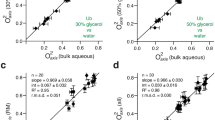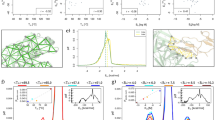Abstract
THE pH of an unbuffered protein solution subjected to a continuous temperature increase usually exhibits a single inflection point associated with the cooperative thermal denaturation of the native protein structure1. Bull and Breese2 have used this procedure to demonstrate that the midpoints (Tm) for the thermal denaturation of 14 proteins correlate with the average residue volumes of their constituent amino acid residues and have proposed that this parameter is the principal determinant of protein thermostability. We report here our study of their proposal by extension of these measurements to include 20 additional well characterised proteins, selected because of their availability in homogeneous form. With this expanded data base, solvent-accessible surface area was found to result in a better correlation with protein thermostability.
This is a preview of subscription content, access via your institution
Access options
Subscribe to this journal
Receive 51 print issues and online access
$199.00 per year
only $3.90 per issue
Buy this article
- Purchase on Springer Link
- Instant access to full article PDF
Prices may be subject to local taxes which are calculated during checkout
Similar content being viewed by others
References
Bull, H. B. & Breese, K. Arch. Biochem. Biophys. 156, 604–612 (1973).
Bull, H. B. & Breese, K. Arch. Biochem. Biophys. 158, 681–686 (1973).
Goodno, C. C., Swenson, C. A. & Bull, H. B. Analyt. Biochem. 67, 220–225 (1975).
Chothia, C. Nature 254, 304–308 (1975).
Teller, D. C. Nature 260, 729–731 (1976).
Fisher, H. F. Proc. natn. Acad. Sci. U.S.A. 51, 1285–1291 (1964).
Chothia, C. & Janin, J. Nature 256, 705–708 (1974).
Klotz, I. M., Darnall, D. W. & Langerman, N. R. in The Proteins, Vol. 1, 3rd edn (eds Neurath, H. & Hill, R. L.) 294–412 (1975).
Bryant, T. N., Watson, H. C. & Wendell, P. L. Nature 247, 14–17 (1974).
McLachlan, A. D. & Walker, J. E. J. molec. Biol. 112, 543–558 (1977).
Bigelow, C. C. J. theor. Biol. 16, 187–193 (1967).
Author information
Authors and Affiliations
Rights and permissions
About this article
Cite this article
STELLWAGEN, E., WILGUS, H. Relationship of protein thermostability to accessible surface area. Nature 275, 342–343 (1978). https://doi.org/10.1038/275342a0
Received:
Accepted:
Issue Date:
DOI: https://doi.org/10.1038/275342a0
This article is cited by
-
CSC01 shows promise as a potential inhibitor of the oncogenic G13D mutant of KRAS: an in silico approach
Amino Acids (2023)
-
Enhancing the thermostability and activity of uronate dehydrogenase from Agrobacterium tumefaciens LBA4404 by semi-rational engineering
Bioresources and Bioprocessing (2019)
-
Probing thermal transitions and structural properties of gluten proteins using ultrasound
Journal of Ultrasound (2013)
-
Prediction of folding stability and degradability of thede novo designed protein MB-1 in cow rumen
Applied Biochemistry and Biotechnology (1997)
-
The stability of extracellular β-glucosidase fromAspergillus niger is significantly enhanced by non-covalently attached polysaccharides
Folia Microbiologica (1996)
Comments
By submitting a comment you agree to abide by our Terms and Community Guidelines. If you find something abusive or that does not comply with our terms or guidelines please flag it as inappropriate.



